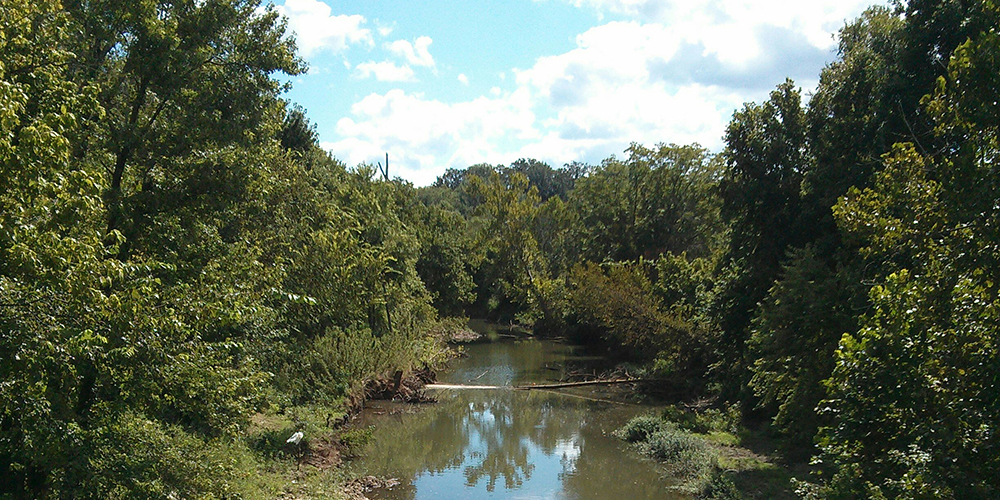Haley McLaughlin, a senior majoring in biological and agricultural engineering and an employee of the Arkansas Water Resources Center, collects a water sample at Baptist Ford on the West Fork of the White River. Photos by Russell Cothren.
The West Fork of the White River is a pretty little stream that starts high up in the Boston Mountains around Winslow. By the time it ends, roughly 28 miles downstream where it merges with the river’s main fork east of Fayetteville, the river is in pretty bad shape.
Which is a problem, because 20 miles north of this confluence, the White River forms Beaver Lake, a 31,000-acre reservoir that provides drinking water for roughly half a million people.
In 1998, the “West Fork,” as locals call it, made the Arkansas Department of Environmental Quality’s 303(d) list of impaired water bodies, meaning there were high concentrations of various “constituents,” including nitrogen, phosphorous, dissolved oxygen, chloride, sulfate and others, all of which conspire to render a river lifeless. The stream also had elevated turbidity, the word ecologists use to describe stirred-up, or cloud-like, sediment, brought in to the river by runoff and erosion. It is sediment, among other things, that delivers the various constituents, or toxins, that impair water quality.
An undesirable tag in any state, impaired status is an ignominious label for a mostly wild stream only a few miles from one of the most desirable places to live in the United States. The West Fork has remained on the list since 1998, and for this reason has received copious attention from state, regional and municipal organizations.
“It’s in better condition than it used to be,” said Brian Haggard, professor of agricultural and biological engineering and director of the Arkansas Water Resources Center, which monitors the West Fork and many other rivers and creeks in Arkansas. “For several years, we saw decreases in sediment concentrations. For the past few years, though, it has leveled off. So, it’s accurate to say that water quality on the West Fork has improved, but we still see high levels for turbidity, chloride and sulfate.”
In one form or another, Haggard and his team have monitored the river since 2003. They initially focused on nitrogen and phosphorous levels but also looked at sediment. An examination of the latter intensified in 2010 when an environmental sciences undergraduate student, under Haggard’s guidance, did his honors thesis on turbidity in the West Fork. Following that project, the center began an ongoing collaboration with Beaver Watershed Alliance, a local, non-profit organization whose mission is to protect water quality in the Beaver Lake watershed, which includes War Eagle Creek, the west, middle and main forks of the White River and the hundreds of washes and small tributaries that feed these rivers. Primarily through streambank stabilization projects, the alliance and other organizations have worked with landowners to reduce erosion and sediment pollution on the West Fork.

The West Fork at Mally Wagnon bridge, near the river’s confluence with Lake Sequoyah.
The alliance and Beaver Water District – the largest of four water-treatment facilities on Beaver Lake – care about the ecological health of the lake’s watershed, because decreasing pollution and improving the overall environmental health of the watershed will make it easier and less expensive for the district to chemically treat, or clean, water taken from the lake.
“The purpose of the turbidity study is to collect scientific data that could potentially result in sections of the river being taken off the ADEQ’s 303(d) list,” said John Pennington, executive director of the Beaver Watershed Alliance. “Then we can focus more intensely on those areas that remain on the list.”
Removing some sections of the river from the impaired list can have important policy and management implications, said Erin Scott, project manager at the water resources center. State and federal money could then be spent on restoration and management of other streams on the list or even targeted toward portions of the West Fork where elevated turbidity is still a problem.
Scott and the center’s staff, including students, have collected water samples at nine sites on the river. Four of these sites – the headwaters at Winslow, Brentwood Mountain Road, Woolsey Bridge near the town of West Fork and Riverside Park in West Fork – are in the Boston Mountains ecoregion and the other five – Baptist Ford south of Greenland, Drake Field northeast of Greenland, Tilly Willy Bridge, Dead Horse Mountain Road and Mally Wagnon Road – are located in the Ozark Highland ecoregion closer to Fayetteville. So far, Scott said, data they’ve collected suggest that the majority of the river does not have turbidity levels that exceed the state’s water quality standard. In fact, only two of the nine sample sites – Mally Wagnon and Dead Horse Mountain – have consistently demonstrated high turbidity.
“Not surprisingly,” says Scott, “these areas are far downstream, near Fayetteville, where the landscape becomes much more urbanized.”
When the project is finished, Haggard and the center’s staff will present their findings to the Arkansas Department of Environmental Quality.
The Water Watchers
The West Fork turbidity study is only one of many water-quality projects performed by the Arkansas Water Resources Center. Housed in the University of Arkansas System Division of Agriculture, the center monitors water quality throughout the state, trains future water scientists and engineers, and helps local, state and federal agencies manage Arkansas’ water resources.
The center is part of a national network of 54 institutions – one in each state, the District of Columbia and three U.S. territories – that comprise the National Institutes of Water Resources, which was founded in 1964 when Congress passed the Water Resources Research Act. The center receives funding from the U.S. Environmental Protection Agency, the U.S. Geological Survey, the Arkansas Game and Fish Commission, and the Arkansas Natural Resources Commission.
Each month, the center analyzes approximately 500 water samples, and sometimes more during the rainy season. It collects samples from 15 sites in Northwest Arkansas on a weekly basis. The center also runs a fee-based water quality laboratory that faculty, industry and the general public can use for water- sample analysis.
With a higher priority on the Illinois River and upper section of the White River, which includes Beaver Lake, the Arkansas Water Resources Center collaborates with the Beaver Watershed Alliance, the Illinois River Watershed Partnership and the Lake Fayetteville Watershed Partnership to ensure safe and clean drinking water for the residents of Northwest Arkansas.
“Really, our purpose is to provide a consistent and reliable program showing how water quality changes over time,” said Brian Haggard, the center’s director since 2008.
A professor of agricultural and biological engineering, Haggard formerly served as president of the National Institutes for Water Resources. Along with current officers and other organization representatives, Haggard lobbies elected officials for additional research funding and Congressional re-authorization of the Water Resources Research Act.





You must be logged in to post a comment.